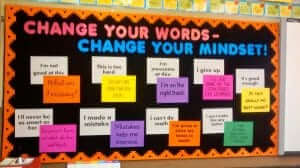“The view you adopt for yourself profoundly affects the way you lead your life. It can determine whether you become the person you want to be and whether you accomplish the things you value.” – Carol Dweck
Research has shown that our mindset plays a big part in determining how far we will go. A fixed mindset assumes that our abilities are innate and immutable, while a growth mindset thinks that we can improve through practice and hard work.
It’s inevitable that students in our class might want to give up at some point. When students feel discouraged, for any range of reasons they can disengage, check out early, or have trouble restarting, finishing, or polishing their work. It’s what we do in that moment that determines whether students will cultivate a growth mindset or not. Teachers with a mindfulness practice of their own know how helpful it is to pause after this quick reaction – to create space for a purposeful response. We need to model this pause for our students so they know that even we struggle to master new concepts and skills.
Here are a few ways to cultivate growth mindset in the classroom!
Make it safe to fail
Cultivating a growth mindset requires an environment where it’s safe to fail. Every time a student announces they’ve “failed,” it’s important to acknowledge their feeling and then help them to name the frustration or fear. When we help them to not judge their reactions but simply normalize it as part of the learning process, we guide them to be realistic about the power of moods and self-talk.
Ask them: “Are you feeling discouraged about this project?” Remind them that it’s ok if they can’t figure out the solution yet. If other students also feel safe to fail, encourage them to side-coach one another.
Encourage students to feel their emotions

We can help our students by noticing how frustration or disappointment feels in their body. If we coach students that even strong “emotions have motion”—they move and change—we can allow moods to just be for a while. Your student who builds up a tolerance for frustration or disappointment will be more secure in knowing they can move on. Soon they’ll be able to notice how they’re talking to themselves, and adjust.
Focus on process over results
Lastly, it helps students to build a growth mindset when the general tone of learning in your classroom is process-based and positive. Look for moments in the day when you can call out what’s happening that’s helpful in the classroom, not only when a student is being obedient or following rules. Articulate your own growth process by noticing your mistakes with humor, your frustration with gratitude, and the many times in the day when your Plan A has to turn to Plan B. Together as a community of learners, you’re building a growth mindset based on mindful self-knowledge.
Learn more about the research-backed Mindful Schools K-12 Curriculum in the Mindful Educator Essentials course.